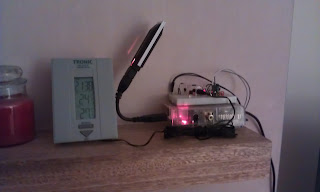Upgraded Raspberry Pi Temperature Server

I've been having a lot of fun messing around with the Raspberry Pi as a server and decided to upgrade the temperature monitor with some more advanced I2C shenanigans. I got 10 LM75 I2C temperature sensors on eBay for less than £3 including the delivery, which was a real bargain. The only drawback was that they are SOIC-8 (i.e. tiny) 8-pin packages, but a small piece of tri-pad copper board and some fine soldering and I was able to come up with the adaptor in the photo below for prototyping purposes. The red LED is just to confirm that 3.3v power is getting to the LM75 on the little breadboard and the white and grey wires are the SCL (clock) and SDA (data) lines for the I2C bus coming from the Raspberry Pi. http://wiltec.no-ip.org (if the server is running, you'll find it above!) Reading temperature data from the LM75 is very simple, but I have hit a minor snag. The LM75 uses a 2 byte data format although the device is essentially 8-bit. ...



